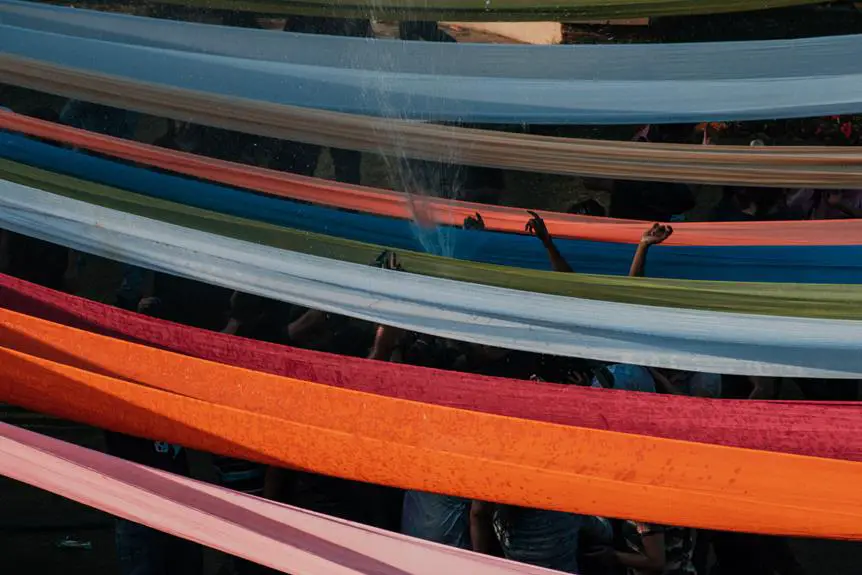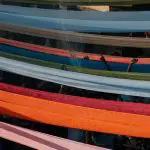Ever had a water stain ruin your favorite fabric? Don't fret! You can easily banish those pesky marks with a few simple tricks.
In this guide, you'll learn how to remove water stains on fabrics like a pro. From assessing fabric compatibility to using natural stain removers, we've got you covered.
By the end, you'll be equipped with the knowledge to tackle any water stain that comes your way. So, let's dive in and say goodbye to those stubborn water stains for good!
Key Takeaways
- Assess the cause of the water stain and the extent of the damage
- Test fabric compatibility and colorfastness before applying stain removal techniques
- Blot and absorb excess water gently without rubbing the stained area
- Utilize natural stain removers such as lemon juice, sunlight, baking soda paste, and white vinegar solution
Understanding Water Stains
Understanding water stains involves identifying the cause and assessing the extent of the damage. When it comes to fabrics, it's crucial to consider their composition to effectively tackle water stains. Different fabric types react differently to water, so understanding the fabric composition is key to successful stain removal.
Identifying the source of the water stain is the first step in the process. Whether it's from rain, a spill, or any other source, knowing the origin helps in determining the best approach for removal. Once you know the fabric composition and the source of the stain, you can proceed with confidence.
Cotton, wool, silk, and synthetic fabrics all have unique properties and react differently to water. Understanding these differences is essential in addressing water stains effectively. For example, while cotton can generally withstand water and stain removal treatments, silk and wool require more delicate care due to their delicate nature.
Assessing Fabric Compatibility
To effectively address water stains on fabrics, you need to assess the compatibility of the fabric with specific stain removal treatments. Fabric testing is crucial before applying any stain removal techniques to ensure that the fabric can withstand the treatment without causing damage.
Here are three important factors to consider when assessing fabric compatibility:
- Fabric Type: Different fabrics react differently to stain removal techniques. For instance, delicate fabrics like silk and wool may require gentler treatments compared to more robust fabrics like cotton or polyester.
- Colorfastness: It's essential to test for colorfastness before treating water stains, especially on colored or patterned fabrics. This helps prevent color bleeding or fading during the stain removal process.
- Special Care Instructions: Some fabrics have specific care instructions provided by the manufacturer. Before attempting any stain removal, check the garment's care label for guidance on suitable cleaning methods to avoid damaging the fabric.
Blotting and Absorbing Excess Water
When it comes to blotting and absorbing excess water from fabrics, the key is to use a clean cloth and avoid rubbing the stained area. Instead, gently press the cloth against the fabric to soak up the water.
Use Clean Cloth
Grab a clean cloth and gently blot the excess water from the stained fabric to prevent further penetration.
Here are three essential tips for using a clean cloth to remove water stains effectively:
- Blot, Don't Rub: Press the cloth onto the stained area, allowing it to absorb the water without spreading the stain.
- Change Cloth Frequently: Use a fresh section of the cloth or a new cloth altogether as it becomes saturated to avoid re-depositing the water back onto the fabric.
- Apply Gentle Pressure: Pat the fabric gently with the cloth to help lift the water without damaging the fibers or pushing the stain deeper.
Using a clean cloth in this way will help to minimize the water damage and prevent the water stain from setting into the fabric.
Press, Don't Rub
To effectively remove water stains from fabrics, proper blotting and absorbing of excess water is essential. When dealing with water stains, remember to press the clean cloth onto the affected area instead of rubbing it. Gentle application of pressure allows the cloth to absorb the water without spreading the stain further. This proper technique is crucial for successful outcome as rubbing can damage the fabric fibers and make the stain more difficult to remove.
Patience Is Key
Exercise patience while blotting and absorbing excess water to effectively remove water stains from fabrics. Developing patience is key to avoiding frustration during this process. Here are some tips to help you master the art of blotting and absorbing excess water:
- Blot gently: Avoid rubbing the fabric vigorously, as this can spread the stain and damage the fibers. Instead, use a soft, clean cloth to gently blot the affected area.
- Use an absorbent material: Place a clean, dry towel or cloth underneath the stained fabric to absorb excess water. Press down firmly to encourage absorption without spreading the stain.
- Repeat as needed: Be patient and persistent. It may take several rounds of blotting and absorbing to completely remove the water stain. Keep at it until the fabric is dry and the stain is gone.
Using Natural Stain Removers
You can remove water stains on fabrics using natural stain removers like lemon juice and sunlight. Lemon juice and sunlight work together to naturally bleach and lift the stain.
Another option is to use a baking soda paste. The baking soda can absorb the water and lift the stain from the fabric.
Alternatively, you can try a white vinegar solution. The white vinegar can help break down the minerals in the water stain and remove it from the fabric.
Lemon Juice and Sunlight
Apply lemon juice directly to the water stains on the fabric and then place the item in direct sunlight to naturally remove the stains. This natural remedy can help you effectively tackle water stains on your favorite fabrics. Here's why it works:
- Lemon Juice: The citric acid in lemon juice acts as a natural bleaching agent, breaking down the water stains on the fabric.
- Sunlight: Direct sunlight amplifies the stain-removing power of lemon juice. The combination of lemon juice and sunlight helps to lighten and lift the water stains from the fabric fibers.
- Gentle Fabric Care: Unlike harsh chemicals, this method is gentle on fabrics and environmentally friendly. It's a great way to care for your garments while effectively removing water stains.
Baking Soda Paste
To continue effectively removing water stains on fabrics, consider using a baking soda paste as a natural stain remover.
Baking soda is a versatile and gentle cleaner that can help lift water stains from various fabrics.
To make the paste, mix a small amount of water with baking soda until it forms a spreadable consistency. Gently apply the paste to the water-stained area, ensuring that it covers the entire affected area.
Allow the paste to sit on the fabric for at least 30 minutes to give it time to absorb and lift the stain.
Afterward, gently brush off the dried paste and launder the fabric as usual.
Baking soda is known for its stain removal properties and is a great addition to your fabric care routine.
White Vinegar Solution
Consider incorporating white vinegar solution as another effective natural stain remover for water stains on fabrics. This solution can further enhance the stain-lifting properties discussed earlier and help restore the fabric to its original state.
Here are three key points to keep in mind when using white vinegar solution for fabric treatment:
- Vinegar application: Mix equal parts of white vinegar and water in a spray bottle and apply the solution directly onto the water stain. Let it sit for a few minutes before gently blotting the area with a clean cloth.
- Fabric treatment: After applying the vinegar solution, launder the fabric as usual, following the care instructions. The vinegar helps to lift the water stain and refresh the fabric.
- Odor elimination: White vinegar also works to eliminate any musty odors that may be associated with water stains, leaving your fabric fresh and clean.
Employing Stain-Specific Techniques
When dealing with water stains on fabrics, start by identifying the specific type of stain you're dealing with. Different stains require different approaches for effective removal. For example, if the water stain is accompanied by a grease or oil residue, using a pre-treatment with a mild detergent can help break down the oils before washing. On the other hand, if the water stain is a result of hard water minerals, a solution of white vinegar and water can be effective in removing the mineral deposits. It's crucial to assess the nature of the stain before taking any action to avoid causing further damage to the fabric.
Fabric protection is also essential in preventing water stains. Applying a fabric protectant spray can provide a layer of defense against liquid penetration, making it easier to remove stains. Additionally, familiarizing yourself with various stain removal techniques can equip you with the knowledge to address specific stains effectively. Understanding the appropriate methods for different types of stains will empower you to preserve the quality of your fabrics.
Machine Washing and Drying
Machine washing and drying are essential steps in effectively removing water stains from fabrics. When it comes to ensuring the best results, consider the following tips:
- Fabric Softeners, Effectiveness: When dealing with water stains on fabrics, it's crucial to choose the right fabric softener. Look for a fabric softener that's specifically designed to combat water stains. These products are formulated to break down and loosen the stain particles, making it easier for the washing machine to remove them during the wash cycle.
- Water Temperature, Impact: The water temperature you use can have a significant impact on the success of removing water stains during machine washing. Hot water is effective for removing tough stains, but always check the fabric care label first to ensure it can withstand higher temperatures. For delicate fabrics, opt for cold water as it can prevent the stain from setting further.
- Proper Drying Techniques: After machine washing, it's important to follow proper drying techniques. For best results, air-dry the fabric in direct sunlight if possible, as the sun's UV rays can help to further lift and remove any residual water stains. If using a dryer, ensure the settings are appropriate for the fabric type to avoid potential damage.
Treating Delicate and Specialty Fabrics
To effectively treat delicate and specialty fabrics for water stains, ensure you select a fabric softener designed specifically for these fabric types. When treating silk, it's essential to use a gentle fabric softener specially formulated for silk to avoid damaging the delicate fibers. For wool, opt for a wool-specific fabric softener to maintain its softness and prevent shrinkage. Here's a helpful table to guide you in treating delicate and specialty fabrics:
| Fabric Type | Recommended Treatment |
|---|---|
| Silk | Use a gentle fabric softener formulated for silk. |
| Wool | Opt for a wool-specific fabric softener to maintain softness and prevent shrinkage. |
Preventing Future Water Stains
You can prevent future water stains on fabrics by using a waterproofing spray designed for the specific fabric type. This simple step can go a long way in protecting your fabrics from moisture and potential stains.
Here are three essential tips for preventing reoccurrence and effectively managing moisture:
- Choose the Right Waterproofing Spray: Look for a waterproofing spray specifically formulated for the type of fabric you want to protect. Different fabrics, such as cotton, wool, or synthetics, may require different types of waterproofing treatments. Be sure to read the label and follow the manufacturer's recommendations for best results.
- Apply Evenly and Thoroughly: When applying the waterproofing spray, ensure that you cover the entire surface of the fabric evenly. Pay special attention to seams, creases, and any areas prone to absorbing moisture. A thorough application will provide more comprehensive protection against water stains.
- Reapply as Needed: Over time, the effectiveness of the waterproofing treatment may diminish, especially with frequent use or exposure to harsh conditions. Keep an eye on the fabric's water resistance and reapply the waterproofing spray as needed to maintain optimal moisture management and protection against water stains.
Frequently Asked Questions
Can Water Stains Be Removed From Delicate Fabrics Like Silk or Wool?
You can remove water stains from delicate fabrics like silk or wool with care. For silk, gently blot the stain with a clean cloth. For wool, use a mild detergent and cold water. Always air dry.
Are There Any Natural Stain Removers That Are Safe to Use on All Types of Fabrics?
For natural remedies, try using lemon juice or white vinegar to remove water stains on fabrics. These eco-friendly options are safe for all types of fabrics. Apply the solution, let it sit, then gently blot the stained area.
How Can I Prevent Water Stains From Forming on Outdoor Furniture Cushions?
To prevent water stains on outdoor furniture cushions, consider using a waterproofing spray to protect the fabric. Regularly clean and dry the cushions to reduce the risk of stains. Additionally, use fabric restoration methods to maintain the cushions' appearance.
Can Water Stains Be Removed From Vintage or Antique Fabrics?
To restore antique textiles, try gentle stain removal methods. For vintage care, consider using mild detergent or vinegar solutions. Avoid rubbing vigorously, and always test a small area first. Fabric restoration requires patience and care.
Are There Any Specific Techniques for Removing Water Stains From Heavily Soiled or Stained Fabrics?
For deep cleaning heavily soiled fabrics with water stains, consider professional services. They have the expertise and specialized tools to effectively remove tough stains and restore the fabric's appearance without causing damage.
- Can You Use Nikwax Products on Gore-Tex? - July 1, 2025
- What Is So Special About Gore-Tex Fabric? - July 1, 2025
- Is Gore-Tex Safe to Wear Against Your Skin? - July 1, 2025




